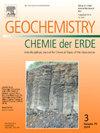Variations in mineral composition and the weathering crust zoning of the REE-Nb chuktukon deposit (Chadobetsky uplift, Krasnoyarsk region)
IF 2.9
3区 地球科学
Q2 GEOCHEMISTRY & GEOPHYSICS
引用次数: 0
Abstract
The Chuktukon REE-Nb deposit occurs within the carbonatite laterite supergene zone Chadobets upland, South of the Siberian craton. A unique laterite profile up to 600 m thick was identified by deep drilling. The laterite developed upon ultramafic lamprophyres and Ti-Th-REE-rich carbonatites. Here we report new mineralogical and geochemical data on carbonatites and laterites that reveal the evolution of supergene processes in the Chuktukon deposit within vertical zonation: (from top to bottom): 1) laterite horizon or ferruginous cap rock (ferricrete); 2) loose ochreous weathering products (ochre zone or regolith zone); 3) secondary phosphate enrichment horizon (apatite-rich zone); 4) unevenly altered disintegrated carbonatites. The bulk contents of CaO and P2O5 increases from primary carbonatite upwards due to the crystallization of carbonate-fluorapatite, and decrease in near-surface horizon due to the high leaching of rocks. The total REE2O3 content is highest in the rocks of the regolith zone and the enriched zone due to the redistribution and concentration of these elements both in the form of impurities and as a result of the redeposition of their own mineral phases. The variations in compositions of apatite, pyrochlore and monazite from different horizons of laterite profile were chosen as a proxy for the REE distribution in the supergene zone. Fluorapatite is gradually being replaced by hydroxyl-fluorapatite and carbonate-hydroxyl-fluorapatite, as the degree of weathering of primary carbonatites increases. Pyrochlore-Ca-Na-F is being replaced by the (Ba![]() Sr)-variety (with Ce and Pb) during the same processes. Monazite changes from (Ce)-dominated to (La)-dominated. This is influenced by the oxidation factor, the consequence of which is also the formation of cerianite in the upper horizon. The study of the mineral and geochemical features of such an object as Chuktukon provides an improved understanding of the patterns of redistribution of the main and ore components of carbonatites in the supergene zone and can be useful in the study of other supergene deposits and delineation of dispersion halos of ore components.
Sr)-variety (with Ce and Pb) during the same processes. Monazite changes from (Ce)-dominated to (La)-dominated. This is influenced by the oxidation factor, the consequence of which is also the formation of cerianite in the upper horizon. The study of the mineral and geochemical features of such an object as Chuktukon provides an improved understanding of the patterns of redistribution of the main and ore components of carbonatites in the supergene zone and can be useful in the study of other supergene deposits and delineation of dispersion halos of ore components.
克拉斯诺亚尔斯克地区Chadobetsky隆起chuktukon REE-Nb矿床矿物组成变化及风化壳分带
Chuktukon REE-Nb矿床赋存于西伯利亚克拉通南侧的Chadobets高地碳酸盐岩红土表生带内。通过深钻发现了厚度达600米的独特红土剖面。红土发育在超镁铁质煌斑岩和富ti - th - ree碳酸盐之上。在此,我们报告了新的碳酸盐岩和红土岩的矿物学和地球化学数据,揭示了Chuktukon矿床在垂直分带内的表生过程演化:(从上到下):1)红土层或含铁盖层(铁铁矿);2)松散的黄褐色风化产物(黄褐色带或风化带);3)次生磷矿富集层(富磷灰石带);4)蚀变不均匀的崩解碳酸盐岩。由于碳酸盐-氟磷灰石的结晶作用,CaO和P2O5的体积含量从原生碳酸盐向上增加,在近地表层由于岩石的高浸出作用而降低。REE2O3总含量在风化带和富集带的岩石中最高,这是由于这些元素以杂质形式重新分布和富集,以及它们自身矿物相的再沉积的结果。选取红土剖面不同层位磷灰石、焦绿石和独居石组成的变化作为表生带稀土元素分布的代表。随着原生碳酸盐风化程度的增加,氟磷灰石逐渐被羟基氟磷灰石和碳酸盐-羟基氟磷灰石所取代。在相同的过程中,焦绿石- ca - na - f被(BaSr)-品种(含Ce和Pb)所取代。独居石由(Ce)为主转变为(La)为主。这受氧化作用的影响,氧化作用的结果也是上部层位铈质的形成。对楚克图孔这类天体的矿物和地球化学特征的研究,有助于我们更好地认识表生带碳酸盐岩主要成分和矿石成分的再分布规律,对其他表生矿床的研究和矿石成分弥散晕的圈定也有借鉴意义。
本文章由计算机程序翻译,如有差异,请以英文原文为准。
求助全文
约1分钟内获得全文
求助全文
来源期刊

Chemie Der Erde-Geochemistry
地学-地球化学与地球物理
CiteScore
7.10
自引率
0.00%
发文量
40
审稿时长
3.0 months
期刊介绍:
GEOCHEMISTRY was founded as Chemie der Erde 1914 in Jena, and, hence, is one of the oldest journals for geochemistry-related topics.
GEOCHEMISTRY (formerly Chemie der Erde / Geochemistry) publishes original research papers, short communications, reviews of selected topics, and high-class invited review articles addressed at broad geosciences audience. Publications dealing with interdisciplinary questions are particularly welcome. Young scientists are especially encouraged to submit their work. Contributions will be published exclusively in English. The journal, through very personalized consultation and its worldwide distribution, offers entry into the world of international scientific communication, and promotes interdisciplinary discussion on chemical problems in a broad spectrum of geosciences.
The following topics are covered by the expertise of the members of the editorial board (see below):
-cosmochemistry, meteoritics-
igneous, metamorphic, and sedimentary petrology-
volcanology-
low & high temperature geochemistry-
experimental - theoretical - field related studies-
mineralogy - crystallography-
environmental geosciences-
archaeometry
 求助内容:
求助内容: 应助结果提醒方式:
应助结果提醒方式:


